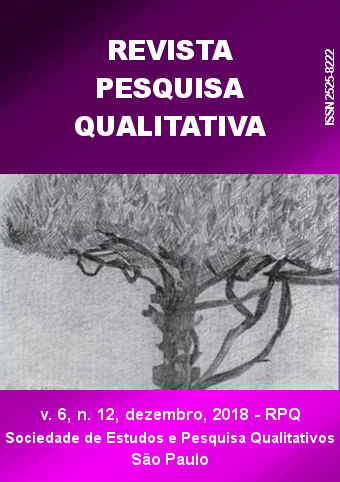A mise-en-scène do “comer em évora”: narrativa, visualidade e storytelling em torno do consumo enogastronómico
DOI:
https://doi.org/10.33361/RPQ.2018.v.6.n.12.171Abstract
Resumo: Analisam-se neste texto as estratégias discursivas mobilizadas para a (re)construção social de lugares e identidades tendo em vista os fins da promoção e consumo turístico enogastronómico. Foi elaborada uma análise qualitativa de conteúdo de base indutiva, alinhada com os pressupostos da grounded-theory e inspirada pelos princípios da análise de narrativas visuais e storytelling à obra Comer em Évora: os restaurantes e as suas receitas, do fotógrafo português J. H. Coelho (2014). A ênfase na história, tradição, autenticidade e personalização, seja pela via familiar, seja pela figura do chef e cozinha de autor, são as estratégias discursivas que ora reforçam o estereótipo cultural da tradicional cozinha alentejana; ora afirmam uma cozinha diferente, criativa, inovadora e exótica.
Palavras-chave: Consumo; Escrita Enogastronómica; Estudos de Turismo; Métodos Visuais; Turismo Enogastronómico.
The mise-en-scène of “eating in évora”: narrative, visuality and storytelling on food and wine consumption
Abstract: This text analyses the discursive strategies used in the social (re)construction of places and identities aiming the promotion and consumption, from a food and wine tourism perspective. Empirically, it draws on a qualitative analysis, carried out from an inductive perspective, in line with the assumptions of grounded-theory and inspired by visual and storytelling narratives over the book “Comer em Évora: the restaurants and its recipes”, authored by the Portuguese photographer J. H. Coelho (2014). The emphasis on history, tradition, authenticity and personalization, either by the family life or the figure of the chef and author cuisine, constitute the discursive strategies used to reinforce both the cultural stereotype on the traditional Alentejo cuisine and a different, creative, innovative and exotic cuisine.
Keywords: Consumption; Food Writing; Tourism Studies, Visual Methods; Food and Wine Tourism.
Downloads
References
AMARAL, R.; et al. Gastronomy and Wines in the alentejo Portuguese Region: Motivation and satisfaction of tourists from Évora. In: PERIS-ORTIZ, M.; et al. (Eds.). Wine and Tourism: A strategic segment for sustainable economic development. 1. ed. Cham: Springer, 2016. p. 179-192.
BANKS, M. Using Visual Data in Qualitative Research. 1. ed. Sage: London, 2007.
BARDIN, L. L’Analyse de Contenu. 1. ed. Paris: Presses Universitaires de France, 1977.
BAUMAN, Z. Consuming Life. 1. ed. Cambridge: Polity Press, 2007.
BEARDSWORTH, A.; KEIL, T. Sociology on the Menu: An Invitation to the Study of Food and Society. 1. ed. Oxon: Routledge, 1997.
BILOU, F. Comer em Évora com um pouco de história. In: COELHO, J. H. Comer em Évora: os restaurantes e as suas receitas. 1. ed. Mem Martins: Visual Factory, 2014. p. 13-14.
BORGES, M. R.; SERRA, J.; MARUJO, N. Visitor profiles at world cultural heritage sites: an empirical study of Évora, Portugal. In: JIMÉNEZ, J.M.; et al. (Eds.). Methods and Analysis on Tourism and Environment. 1. ed. New York: Nova Science Publishers, 2013. p. 93–108.
BOURDIEU, P. La Distinction. 1. ed. Paris: Seuil, 1979.
BRIEN, D. L.; WESSELL, A. Cookbook: A New Scholarly View. M/C Journal, Queensland, v. 16, n. 3, s.p., june. 2013. Disponível em: <http://journal.media-culture.org.au/index.php/mcjournal/article/view/688>. Acesso em: 12 nov. 2017.
CHANEY, D. Lifestyles. 1. ed. London: Routledge, 1996.
COELHO, J. H. Comer em Évora: os restaurantes e as suas receitas. Mem Martins: Visual Factory, 2014.
CONFRARIA GASTRONÓMICA DO ALENTEJO. Carta Gastronómica do Alentejo. Monumenta Transtaganae Gastronomica. S.l.: Entidade Regional de Turismo do Alentejo. 2013.
COSTA, R. On the Timelessness and Timeliness of Categorical Analysis: the Past, Present, and Yet to Come of searching for Latent Meanings. Communication Studies, Covilhã , v. 19, p. 79-106, may. 2015.
COSTELLO, M. Reading the Senses: Writing about Food and Wine. M/C Journal, Queensland, v. 16, n. 3, s.p., june. 2013. Disponível em: <http://journal.media-culture.org.au/index.php/mcjournal/article/view/651>. Acesso em: 06 out. 2017.
FEATHERSTONE, M. Consumer Culture and Postmodernism. 1. ed. London: Sage, 1991.
FERGUSON, P. P. A Cultural Field in the Making: Gastronomy in 19th Century France. American Journal of Sociology, Chicago, v. 104, n. 3, p. 597–641, nov. 1998.
FERGUSON, P.; ZUKIN, S. What’s Cooking? Theory and Society, Dordrecht, v. 24, n. 2, p. 193–99, apr. 1995.
FLICK, U. Métodos Qualitativos na Investigação Científica. 1. ed. Lisboa: Monitor, 2005.
GABRIEL, Y.; LANG, T. The Unmanageable Consumer – Contemporary Consumption and its Fragmentation. 1. ed. London: Sage, 1995.
GALOPIM DE CARVALHO, A. M. Prefácio. In: COELHO, J. H. Comer em Évora: os restaurantes e as suas receitas. 1. ed. Mem Martins: Visual Factory, 2014. p. 7-8.
GLASER, B.; STRAUSS, A. The Discovery of Grounded Theory: Strategies for Qualitative Research. 1. ed. Chicago: Aldine Publishing Company, 1967.
GRONOW, J. The Sociology of Taste. 1. ed. London: Routledge, 1997.
HALL, C. M. et al. (Eds.). Food Tourism around the World: Development, Management and Markets. 1. ed. Oxford, UK: Butterworth-Heinemann, 2003.
HOBSBAWN, E.; RANGER, T. The Invention of Tradition. 1. ed. Cambridge: University Press, 1983.
JOHNSTON, J.; BAUMANN, S. Democracy versus Distinction: A Study of Omnivorousness in Gourmet Food Writing. American Journal of Sociology, Chicago, v. 113, n. 1, p. 65-204, jul. 2007.
JOKELA, S.; RAENTO, P. Collecting visual materials from secondary sources. In: RAKI?, T.; CHAMBERS, D. (Ed.). An Introduction to Visual Research Methods in Tourism. 1. ed. London: Routledge, 2012. p. 53-69.
KIM, Y. G.; EVES, A.; SCARLES, C. Building a model of local food consumption on trips and holidays: A grounded theory approach. International Journal of Hospitality Management, Amsterdam, v. 28, p. 423–431, sept. 2009.
KIVELA, J.; CROTTS, J. C. Gastronomy tourism: A meaningful travel market segment. Journal of Culinary Science and Technology, Philadelphia, v. 4, n. 2-3, p.39–55, sep. 2005.
KLANTEN, R.; EHMANN, S.; SCHULZE, F. Visual Storytelling: Inspiring a New Visual Language. 1. ed. Berlin: Gestalten Verlag, 2011.
KORSMEYER, C. (Ed.). The Taste Culture Reader: Experiencing Food and Drink. 1. ed. Oxford: Berg Publishers, 2005.
KRIPPENDORFF, K. Content Analysis: An Introduction to Its Methodology. 2. ed. Beverly Hill, CA: Sage Publications, 2003.
LÉVI-STRAUSS, C. Le Triangle Culinaire. L’Arc, Aix-en-Provence, n. 26, p. 19-29. 1965.
MARUJO, N.; SERRA, J.; BORGES, M. R. Visitors to the city of Évora: Who are they? European Journal of Tourism, Hospitality and Recreation, Leiria, v. 3, n. 2, p. 91–108. 2012.
MIELE, M.; MURDOCK, J. The Practical Aesthetics of Traditional Cuisines: Slow Food in Tuscany. Sociologia Ruralis, Assen, v. 42, n. 4, p. 312–328, oct. 2002.
MILLER, D. (Ed.). Acknowledging Consumption. 1. ed. London: Sage, 1996.
PALMER, C. Moving with the Times: Visual representations of the tourism phenomenon. Journal of Tourism Consumption and Practice, v. 1, n. 1, p. 74-85. 2009.
PINK, S. Doing Visual Ethnography. 1. ed. London: Sage, 2001.
POULAIN, J.-P. Sociologies de l’Alimentation. 1. ed. Paris: Presses Universitaires de France, 2002.
PROSSER, J. (Ed.). Image-based Research: A Sourcebook for Qualitative Researchers. 1. ed. London: Falmer Press, 1998.
QUITÉRIO, J. Gastronomia e a Identidade Cultural. Santarém: Ed. Festival Nacional de Gastronomia, 1994.
RAKI?, T.; CHAMBERS, D. (Ed.). An Introduction to Visual Research Methods in Tourism. 1. ed. London: Routledge, 2012.
RAMOS, F. M. A Cozinha Alentejana. In RAMOS, F. M. Breviário Alentejano. Casal de Cambra: Caleidoscópio, 2006. p. 94-98.
RAMOS, F. M. Vinho do Alentejo. Temas Culturais. 1. ed. Lisboa: Edições Colibri, 2010.
ROSE, G. Visual Methodologies: An Introduction to the Interpretation of Visual Materials. 1. ed. London: Sage, 2001.
SARAMAGO, A. Gastronomia Património Cultural: Com os Olhos Postos no Futuro, Reflexões sobre o Turismo em Portugal. 1. ed. Lisboa: Ed. Ministério da Economia, 2002.
SCARLES, C. Where words fail, visual ignite: Opportunities for visual autoethnography in tourism research. Annals of Tourism Research, New York, v. 37, n. 4, p. 905-926, oct. 2010.
SHIRATO, T.; WEBB, J. Reading the Visual. 1. ed. Crows Nest: Allen & Unwin, 2004.
SILKES, C.; CAI, L.; LETHO, X. Marketing to the Culinary Tourist. Journal of Travel & Tourism Marketing, v. 30, n. 4, p. 335-349, may. 2013.
SIMPLÍCIO, M. D.; CAMELO, N. S. O reforço do turismo como setor estruturante em Évora. Cadernos de Geografia, Coimbra, v. 34, s.n., p. 43-52, 2015.
SIMS, R. Food, place and authenticity: local food and the sustainable tourism experience. Journal of Sustainable Tourism, Clevedon, v. 17, n. 3, p. 321–336, may. 2009.
SMITH, V. L. (Ed.). Hosts and Guests. The Anthropology of Tourism. 1. ed. Philadelphia. University of Pennsylvania Press, 1977.
SOUTHERTON, D. Analysing the Temporal Organization of Daily Life: Social Constraints, Practices and their Allocation. Sociology, Manchester, v. 40, n. 3, p. 435–454, june. 2006.
TURISMO DE PORTUGAL. Gastronomia e Vinhos. Lisboa: Turismo de Portugal, 2006.
TURISMO DE PORTUGAL. Plano Estratégico Nacional do Turismo. Revisão e Objetivos 2013-2015. Lisboa: Turismo de Portugal, 2013.
UNWTO. UNWTO Tourism Highlights: 2017 Edition. Madrid: United Nations World Tourism Organisation, 2017.
URRY, J. The Tourist Gaze. 1. ed. London: Sage, 1990.
URRY, J. Consuming Places. 1. ed. London: Sage, 1995.
WARDE, A. Consumption, Food and Taste – Culinary Antinomies and Commodity Culture. 1. ed. London: Sage, 1997.
WARDE, A. Consumption and Theories of Practice. Journal of Consumer Culture, v. 5, n. 2, p. 131–153, july. 2005.
Downloads
Published
How to Cite
Issue
Section
License
Essa revista é licenciada pelo sistema creative commons 4.0, não-comercial.
















